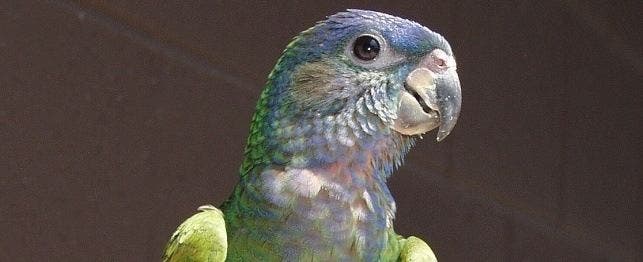
Choosing a Blue-Headed Pionus
Blue-headed pionus are one of the most popular and well known of all pionus parrots. They are intelligent, inquisitive birds that sometimes bond fiercely to their owner.
They make very good pets but don’t typically speak well. Pionus are the most common and widespread parrot throughout Central and South America, especially Costa Rica and the Amazon basin.
Appearance and Personality
Blue-headed pionus (Pionus menstruus) are medium, stocky bright green parrots with deep blue heads and black ear patches. They are also known as red-vented parrots for the bright red under-tail coverts that are actually a hallmark of pionus parrots. Primary and secondary flight feathers and tail feathers are green. The beak is black with red side patches.
The blue-headed pionus is intelligent and can be a little shy. Mature birds, especially males, may become bonded to one person and aggressively protect that person from other people, including other family members. They are active by nature and may become overweight if closely confined.
Blue-headed pionus can probably live up to 35 to 45 years or more. Little is known about their life span in captivity.
Blue-headed pionus should always be provided with toys, blocks of wood or branches that they can chew. In order to ensure safety, companion pionus parrots should not be allowed unsupervised freedom in the home as they often encounter toxins or dangerous items. Young birds should be socialized to many people and exposed to a variety of situations such as new cages, toys, visits to the veterinarian, handling by friends, and wing and nail clips, to avoid fear of novel situations. They need to have some space for exercise.
Feeding
Pionus parrots should be fed a formulated (pelleted or extruded) diet as a basis for good nutrition. They should be fed approximately two heaping tablespoons to 1/4 cup of pellets. They will tend to waste less food if fed small sized pellets. The diet should be supplemented with the same volume of fresh fruits and vegetables daily to add variety and psychological enrichment. Monitor food intake. Overfeeding leads to pickiness, selective feeding and wasteful throwing of food. Pionus parrots should be fed little to no sunflower or safflower seeds or seeds should only be given as treats. Vitamin supplements are not needed for birds that are eating a formulated diet.
Birds fed only seeds will need vitamin and mineral supplementation to prevent deficiency diseases. Preferably vitamins should be added to soft food rather than putting in the water as this dilutes the vitamins. Water soluble vitamins break down rapidly and water sweetened with vitamins is a good growth medium for bacteria. Vitamins added to the outside of seeds is usually lost when the bird shells the seeds.
Grooming
Routine bathing or showering is vital to maintaining good plumage and skin condition. Birds can be misted and allowed to dry in a warm room, in the sun, or gently dried with a blow drier. Care should be taken not to clip the wing feathers excessively as pionus parrots often fall and injure themselves. Clip only the primary flight feathers and only enough so the bird will glide to the floor. Blue-headed pionus are heavy bodied and care must be taken not to cut too many feathers. Excessive wing clipping can result in injuries from falling.
Housing
Blue-headed pionus are very active and should be provided the largest cage that space and budget allows. Ideally the cage should provide room for flight. Durable cage construction is not as critical as it is for macaws and cockatoos. Locks or escape proof latches may be necessary on cages. Ideally the bird will have an outdoor cage as well to allow playtime in the fresh-air and sunlight.
Breeding
Blue-headed pionus are moderately difficult to breed in captivity. In North America blue-headed pionus breed predominantly in the spring and have a limited breeding season typically from February or March to June or July. Clutch size is typically three to four eggs. One inch by one inch by 14 gauge welded wire, or 1-inch by 1/2-inch welded wire is a good choice for cage construction. A suggested size is 4 feet wide by 4 feet tall by 6 to 8 feet long suspended 4 feet above the ground or floor.
A grandfather style wooden nest box can be used. Size should be approximately 10 inches by 10 inches by 18 to 24 inches.
Incubation period is approximately 24 to 26 days. Chicks will usually fledge at approximately 8 to 10 weeks of age. Blue-headed pionus are difficult to hand-rear from the egg. For best results they should be initially fed by the parents or fed very often in the first week.
Male blue-heads are occasionally aggressive toward their mates. Clipping the wings of the male prior to the breeding season may be necessary in aggressive individuals to help the female escape in case the male becomes aggressive. Males in breeding condition can be very aggressive to keepers. They will often approach the keeper and flare the tail in an aggressive posture.
Blue-heads are moderately noisy when in breeding season. When breeding pionus parrots, noise and proximity to neighbors must be considered.
Common Diseases and Disorders
The blue-headed pionus is a relatively healthy bird. The following diseases have been reported in this species:
- Pox virus infection (Primary disease of imported birds)
- Feather-picking
- Aspergillosis
- Vitamin A deficiency
- Psittacosis
- Poor eating habits
- Bacterial and fungal infections
- Mate aggression
- Toxicity, ingestion of metals
- Toe necrosis